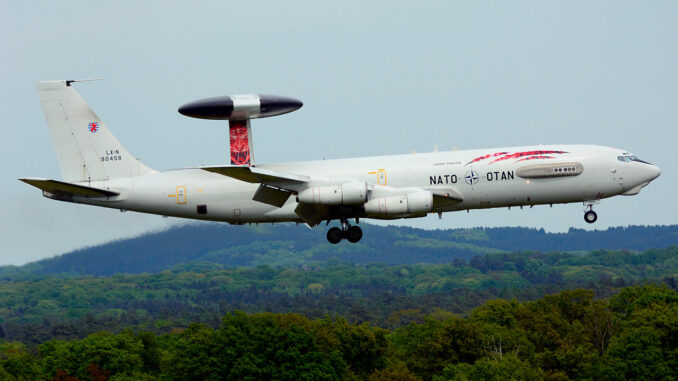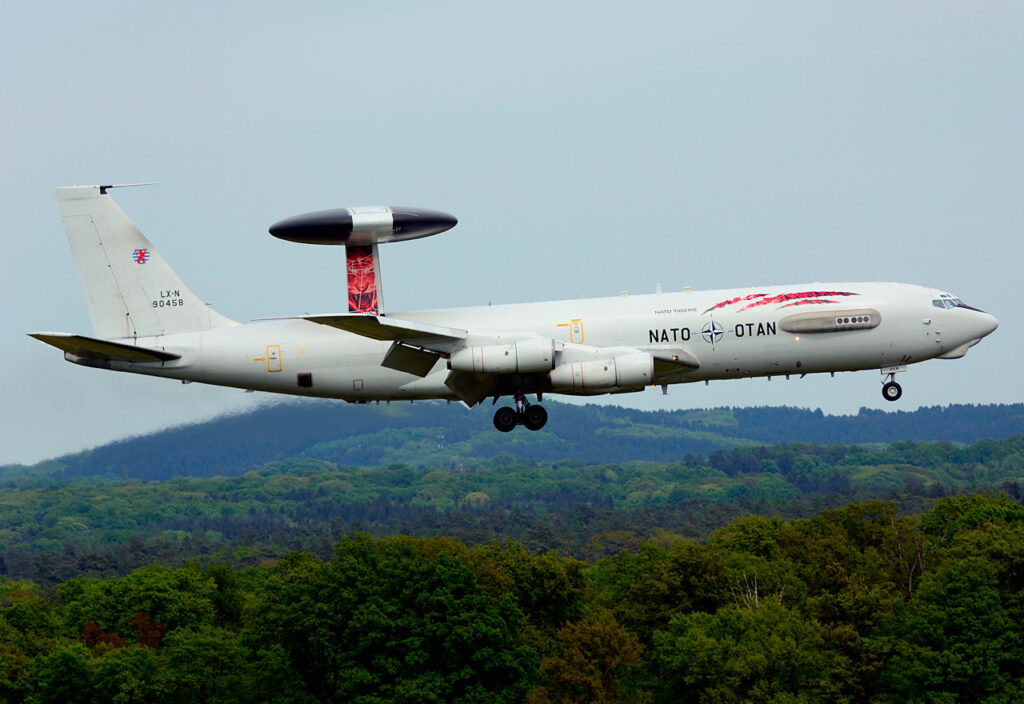
NATO AWACS surveillance flights over Romania aim to reinforce the Allied presence and monitor Russian military activity.
Since September 29, 2024, NATO has reinforced its air presence in Romania by deploying AWACS (Airborne Warning and Control System) surveillance aircraft. These aircraft, based in Preveza, Greece, monitor Russian military activity near Romania’s borders and support the country’s defensive capabilities. This operation, recommended by the Joint Force Command in Naples, is part of an increased vigilance against the intensification of air activity near the Romanian border. The flights are carried out over the territory of NATO member countries, and respect the principles of legitimacy, transparency and proportionality.
The deployment of AWACS aircraft: a strategic response
For several years, Russian military presence on the borders of Eastern Europe has given rise to growing concern. In response, NATO has stepped up its air surveillance and deployed AWACS aircraft in Romania from September 29, 2024. These aircraft are equipped with advanced radar and surveillance systems, capable of tracking air and ground activity over distances of up to 400 km. Based in Preveza, Greece, these aircraft can carry out continuous flights over Alliance territory, while monitoring military movements on Romania’s borders with Russia.
AWACS aircraft enable real-time surveillance, detecting potential threats and providing essential strategic information to commanders on the ground. By supporting Romania’s air defense, these aircraft reinforce the country’s rapid reaction capability in the event of incursion or escalation in the region. The main objective is to deter any aggressive action by keeping a close watch on Russian military forces.
This surveillance operation is crucial, not least because of the increase in Russian air activity close to NATO’s borders. In 2023, Russia increased its military flights along Europe’s eastern borders, raising concerns among NATO member states, particularly those near the Black Sea.
Air safety issues in Eastern Europe
Romania, a NATO member since 2004, occupies a key geostrategic position in the Black Sea region. Tensions with Russia have increased since the annexation of Crimea in 2014 and the escalation of the conflict in Ukraine. These events have prompted the Alliance to strengthen its military presence in the region, with the creation of forward bases and the regular deployment of multinational troops. AWACS aircraft play a central role in this strategy, providing continuous surveillance of air and sea movements.
The Black Sea is a nerve center for Russian military operations, and its proximity to NATO countries such as Romania and Bulgaria makes it a zone of potential tension. Surveillance of the coasts and airspace over this region has therefore become a priority for the Alliance. AWACS aircraft can simultaneously detect and track up to 300 targets at a time, ensuring complete coverage of the area and reinforcing Romania’s defense systems.
This increased vigilance in Eastern Europe is also aimed at preventing violations of NATO airspace, which have become more frequent in recent years. Between 2021 and 2023, several incursions by Russian fighters were reported near Romanian airspace, prompting NATO to deploy more fighter aircraft to intercept these intrusions.

Transparency and proportionality in NATO operations
AWACS flights over Romania are carried out within the framework of NATO’s fundamental principles: legitimacy, proportionality and transparency. Each mission is coordinated with the Romanian authorities and fully complies with international agreements on military flights over the territory of member countries. AWACS aircraft do not venture outside Alliance borders, and operate strictly within the airspace of Romania and other NATO members.
The transparency of these operations is essential to maintain a balance in the region and avoid any unintentional escalation. Flights are announced publicly, and information gathered is shared with NATO allies to ensure a coordinated response to any threat. In addition, NATO endeavors to communicate clearly the defensive nature of these missions, emphasizing that they are not a provocation, but a necessary measure to monitor and deter hostile military activity near the Alliance’s borders.
The proportionality of these operations is also a key point. The aim is not to intensify the militarization of the region, but rather to reinforce air security and ensure constant surveillance in the face of increasing Russian military activity. NATO is seeking to avoid any escalation, while maintaining a rapid reaction capability if necessary.
The consequences of surveillance flights for Romania
The reinforcement of AWACS surveillance flights in Romania has positive consequences for the country’s security. Firstly, it improves Romania’s ability to react quickly to any potential incursion by the Russian army. By monitoring military activity on its borders, Romania can adjust its defense forces and prevent any unexpected escalation. The information gathered by the AWACS aircraft is transmitted in real time to Romanian commanders, enabling them to better anticipate threats.
These flights also strengthen military cooperation between Romania and other NATO member countries. By working in close collaboration with other allied forces, Romania can benefit from the Alliance’s collective resources, thus increasing its defensive effectiveness. This cooperation is part of a broader strategy to strengthen collective security in Eastern Europe, in the face of the persistent threat from Russia.
Last but not least, AWACS flights in Romania also have a significant deterrent impact. By showing that NATO is actively monitoring the region, it sends a strong message to Moscow that any aggressive military activity will be detected and closely monitored. This deterrence could help stabilize the region and prevent future escalations.
War Wings Daily is an independant magazine.